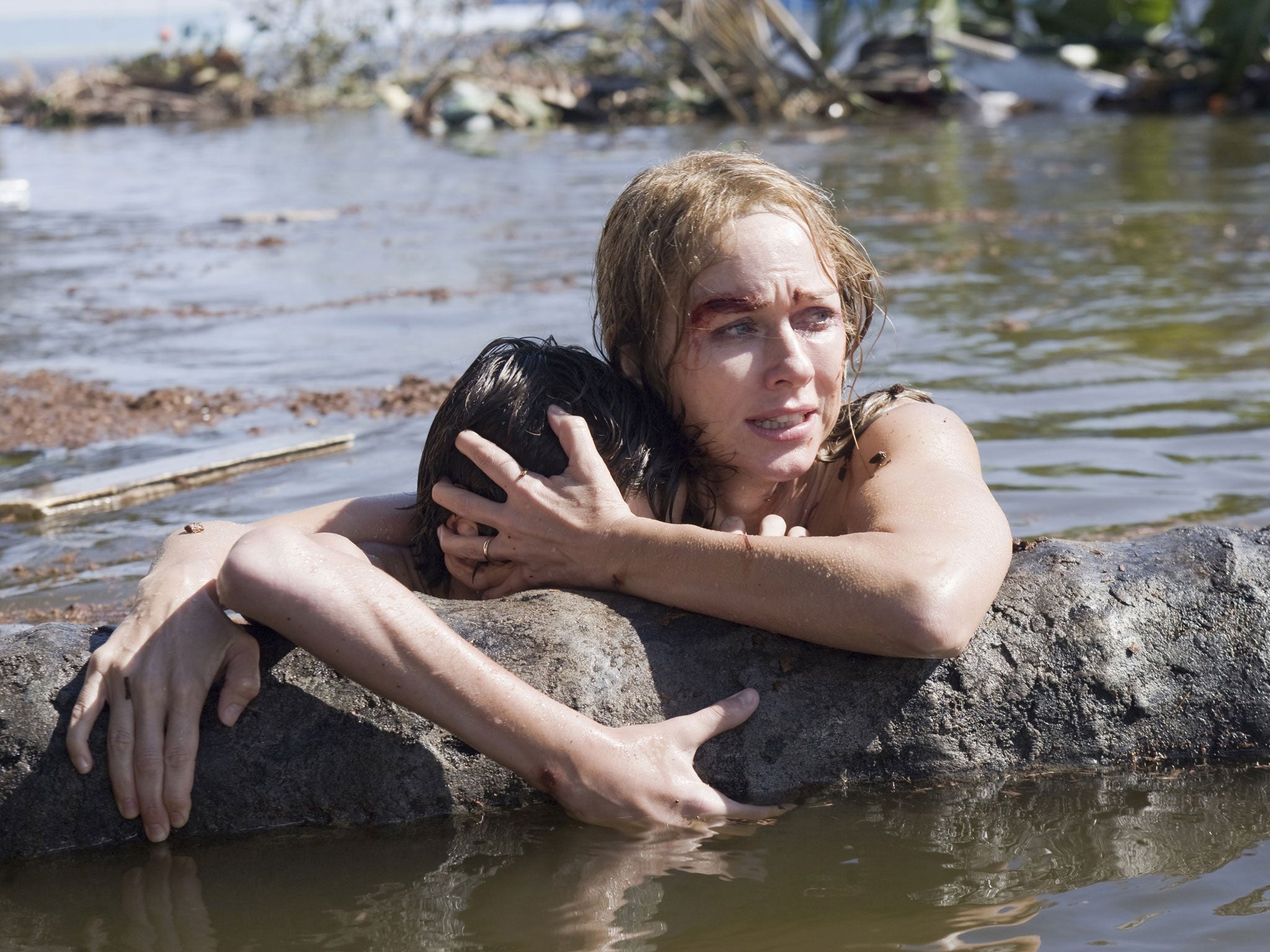Film review: The Impossible, Naomi Watts makes waves, but it's not a perfect storm
(12A)

We can't get enough of disaster movies. Whatever the scale of horror and devastation they depict, we know that somebody will survive. (United 93, about the hijacked plane that fought back on 9/11, is the only recent exception). The suspense concerns which ones will survive. Who will have the nerve, or the nous, or the sheer good fortune, to escape catastrophe? And what proportion of survivors is required to send home an audience with a sense of catharsis, if not a happy ending – 10 per cent? Five? A handful?
That last question may occur to you during The Impossible, which vividly re-creates the Indian Ocean tsunami of 26 December, 2004. But it may not actively trouble you until later, when you've got past the mind-numbing desolation that the disaster leaves in its wake. Spanish director Juan Antonio Bayona (The Orphanage) has taken on enormous challenges with this movie, and on a technical basis at least he carries all before him. For the manipulation of digital imagery it should give Life of Pi a run for its money come awards season, and the sound design also plays a significant role in its atmospheric build-up. Just listening to the 10 seconds of wind rush immediately before the tsunami breaks is enough to make you hide under your seat.
The dramatic focus of the movie is an English couple, Maria (Naomi Watts) and Henry (Ewan McGregor), living in Japan. They've just arrived at a Thai beach resort for Christmas with their three young sons, though all is not well. He's worried about losing his job, and she's wondering if she should go back to work as a doctor. Such anxieties look destined to be put into perspective.
There's a strange rustling in the air, and a breeze picks up. We know that this is the lull before the storm, but the holidaymakers don't, and the speed at which calamity bursts in on them is genuinely shocking. One minute they're on dry land, the next they're gargling through a watery chaos. I don't know how the effects team managed it, but hell, does it look – and sound – like the real thing. Beach houses collapse like matchsticks as the flood thunders forward, and for a moment we're writhing under the turbid swell with Watts, narrowly dodging the debris that would knock her lights out forever. She manages to get to the surface, where her eldest boy Lucas (Tom Holland, a fine newcomer) is also trying to stay afloat.
Somehow the pair of them fight their way out of the death zone. They clamber up a tree, where it might be safe, though the mother is in agony from a leg wound. This is the beginning of a personal Calvary, and Watts gives it her all – even when she seems to be unconscious. Again, the make-up is a technical triumph. When they reach a hospital, itself overwhelmed with the injured and dying, Watts looks so painfully depleted you can scarcely believe she's not at death's door. Her skin colour goes from hangover-grey to cadaverous blue. "Am I dead?" she asks at one point, not unreasonably. Sent on a mission to help around the stricken wards, 11-year-old Lucas does his best in dreadful circumstances. On returning to his mum he finds her bed empty, and we are plunged into another crisis. Imagine every Spielberg mother-and-son separation rolled into one, and you're getting there. It's impossible not to be moved.
An hour or so has gone by now, and you wonder what's become of Ewan McGregor. But here he is, searching through the wreckage for his wife and Lucas. He's got his two youngest with him, and now we see where the story's going. (The screenplay is based, by the way, on what happened to a Spanish family of five – presumably it was box-office considerations that changed them to English-speakers).
McGregor has to join the bedraggled masses of other survivors trying to reach their loved ones, gesturing at a broader picture of loss. Unfortunately, it has the effect of making this story look rather tactless. Nearly a quarter of a million people died in the Asian tsunami, but for the purposes of this movie they form merely an amorphous backdrop to one family's trauma. It is not much consolation to know that many of the film's extras were local people who lost family members in the disaster. Weren't their stories just as valid?
The narrowness of focus looks increasingly awkward as the film goes on. Dispersed though they are, this family has survived the flood; now they must somehow find their way back to one another. But do we really care, after all we've been shown? The last third of the movie indulges a kind of charade of near-misses in the overburdened hospital, as Watts thinks she glimpses her husband, and Lucas almost crosses paths with his dad. A tragedy of mass destruction is reduced to fit an old movie trope.
This isn't to deny the family's bravery and resourcefulness in the face of life-threatening terrors, or to berate the film-makers for picking one story from many thousands of others. You should see it anyway for Watts's amazing performance, and for the portrayal of the tsunami's awesome energy and destructiveness. But The Impossible seems complacent, all the same, and even a bit heartless in its salute to one family of white Western tourists. It's much easier to never say die when your privileged status has secured access to medical help and enormous slices of luck.
Subscribe to Independent Premium to bookmark this article
Want to bookmark your favourite articles and stories to read or reference later? Start your Independent Premium subscription today.

Join our commenting forum
Join thought-provoking conversations, follow other Independent readers and see their replies